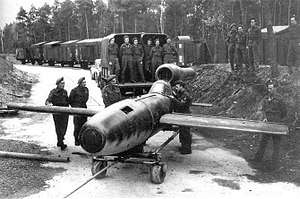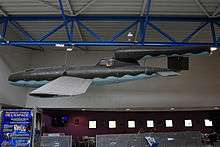Fieseler Fi 103R Reichenberg
The Fieseler Fi 103R, code-named Reichenberg, was a late-World War II German crewed version of the V-1 flying bomb (more correctly known as the Fieseler Fi 103) produced for attacks in which the pilot was likely to be killed (as actually intended, for use of the Imperial Japanese Naval Air Service's Ohka rocket-powered kamikaze suicide anti-ship missile) or at best to parachute down at the attack site, which were to be carried out by the "Leonidas Squadron", V. Gruppe of the Luftwaffe's Kampfgeschwader 200.
| Fi 103R Reichenberg | |
|---|---|
 | |
| Fi 103R Reichenberg (without warhead) captured by British troops in 1945 | |
| Role | Manned missile |
| National origin | Nazi Germany |
| Manufacturer | Fieseler |
| First flight | September 1944 |
| Primary user | Luftwaffe |
| Produced | October 1944 |
| Number built | c.175 |
| Developed from | Fieseler Fi 103 (V-1 flying bomb) |
History
Background
.jpg)
The Leonidas Squadron, part of KG 200, had been set up as a suicide squadron. Volunteers were required to sign a declaration which said, "I hereby voluntarily apply to be enrolled in the suicide group as part of a human glider-bomb. I fully understand that employment in this capacity will entail my own death."[1] Initially, both the Messerschmitt Me 328 and the Fieseler Fi 103 (better known as the V-1 flying bomb) were considered as suitable aircraft, but the Fi 103 was passed over in favour of the Me 328 equipped with a 900 kilograms (2,000 lb) bomb.[2]
However, problems were experienced in converting the Me 328 and Heinrich Himmler wanted to cancel the project. Otto Skorzeny, who had been investigating the possibility of using crewed torpedoes against Allied shipping, was briefed by Hitler to revive the project and he contacted test pilot Hanna Reitsch. The Fi 103 was reappraised and was adopted for the project as it seemed to offer the pilot a slim chance of surviving.[3]
The project was given the codename "Reichenberg" after the capital of the former Czechoslovakian territory "Reichsgau Sudetenland" (present-day Liberec), while the aircraft themselves were referred to as "Reichenberg-Geräte" (Reichenberg apparatus).[3]
DFS development

In the summer of 1944 the DFS (German Research Institute for Sailplane Flight) at Ainring took on the task of developing a crewed version of the Fi 103, an example was made ready for testing within days and a production line was established at Dannenberg.[4]
The V-1 was transformed into the Reichenberg by adding a small, cramped cockpit at the point of the fuselage that was immediately ahead of the pulsejet's intake, where the standard V-1's compressed-air cylinders were fitted. The cockpit had basic flight instruments and a plywood bucket seat. The single-piece canopy incorporated an armoured front panel and opened to the side to allow entry. The two displaced compressed-air cylinders were replaced by a single one, fitted in the rear in the space which normally accommodated the V-1's autopilot. The wings were fitted with hardened edges to cut the cables of barrage balloons.[4] The broader-chord forward support pylon for the Argus pulsejet, by coincidence, resembles the same airframe component used on the American clone of the uncrewed V-1, the Republic-Ford JB-2 Loon.
It was proposed that a He 111 bomber would carry either one or two Reichenbergs beneath its wings, releasing them close to the target. The pilots would then steer their aircraft towards the target, jettisoning the cockpit canopy shortly before impact and bailing out. It was estimated that the chances of a pilot surviving such a bailout were less than 1% due to the proximity of the pulsejet's intake to the cockpit.[5]
Variants
There were five variants:[6][7] By October 1944 about 175 R-IVs were ready for action.[8]
- R-I – The basic single-seat unpowered glider.
- R-II – Unpowered glider; had a second cockpit fitted where the warhead would normally be.
- R-III – A pulsejet-powered two-seater.
- R-IV – The standard-powered operational model.
- R-V – Powered trainer for the Heinkel He 162 (shorter nose).
Operational history
Training
Volunteers trained in ordinary gliders to give them the feel of unpowered flight, then progressed to special gliders with shortened wings which could dive at speeds of up to 300 kilometres per hour (190 mph). After this, they progressed to the dual-control R-II.[5]
Training began on the R-I and R-II and, although landing them on a skid was difficult, the aircraft handled well and it was anticipated that the Leonidas Squadron would soon be using the machines. Albert Speer wrote to Hitler on 28 July 1944 to say that he opposed wasting the men and machines on the Allies in France and suggested it would be better to deploy them against Russian power stations.[5]
Test flights

The first real flight was performed in September 1944 at the Erprobungsstelle Rechlin, the Reichenberg being dropped from a Heinkel He 111. However, it subsequently crashed after the pilot lost control when he accidentally jettisoned the canopy. A second flight the next day also ended in a crash and subsequent test flights were carried out by test pilots Heinz Kensche and Hanna Reitsch. Reitsch herself experienced several crashes, which she survived unscathed.[5] On 5 November 1944 during the second test flight of the R-III, a wing fell off due to vibrations and Heinz Kensche managed to parachute to safety, albeit with some difficulty due to the cramped cockpit.[9]
Cancellation
When Werner Baumbach assumed command of KG 200 in October 1944, he shelved the Reichenberg in favour of the Mistel project. He and Speer eventually met with Hitler on 15 March 1945 and managed to convince him that suicide missions were not part of the German warrior tradition and later that day Baumbach ordered the Reichenberg unit to be disbanded.[9]
Aircraft on display
- Flying Heritage Collection, Everett, Washington[10]
- Canadian War Museum, (under restoration 2009).
- Lashenden Air Warfare Museum, Headcorn, Kent,[11] (restored N° 85)
- La Coupole, Saint-Omer, France.,[12] (restored N° 126)
- Schweizerisches Militärmuseum Full, Full-Reuenthal, Switzerland, (restored N° 27)
- Stinson Air Field, San Antonio, Tx, United States[13] (replica).
- National Military Museum (Soesterberg) Netherlands (on temporary display)
Specifications (Fi 103R-IV)
Data from The warplanes of the Third Reich[14]
General characteristics
- Crew: 1
- Length: 5.72 m (18 ft 9 in)
- Wingspan: 8.00 m (26 ft 3 in)
- Gross weight: 2,250 kg (4,960 lb)
- Powerplant: 1 × Argus As 109-014 pulsejet, 2.9 kN (660 lbf) thrust - static thrust: 2.2 kN (500 lbf); max thrust: 3.6 kN (800 lbf)[15][16]
Performance
- Cruise speed: 650 km/h (400 mph, 350 kn) at 2,400 m (8,000 ft)
- Never exceed speed: 800 km/h (500 mph, 430 kn)
- Range: 329 km (204 mi, 178 nmi) from point of launch, cruising at 2,500 m (8,200 ft)
- Endurance: 32 minutes
Armament
850 kg (1,874 lb) high-explosive warhead
See also
- Fieseler Fi 103 (V-1 flying bomb)
- Kawanishi Baika (IJN)
- Leonidas Squadron, KG 200's "suicide unit".
- Yokosuka MXY-7 Ohka, the Japanese suicide rocket aircraft.
References
| Wikimedia Commons has media related to Fieseler Fi 103R. |
Notes
- Gilbert, Sir Martin (2004). The Second World War. Henry Holt and Co. pp. 504. ISBN 0-8050-7623-9.
- Hyland, p. 219
- Renneberg, p. 115
- Hyland, p. 220
- Hyland, p. 221
- Kay, p. 84
- O'Neill, p. 192
- O'Neill, p. 193
- Zaloga, p. 39
- Flying Heritage Museum – Artifacts Archived 2016-03-04 at the Wayback Machine Retrieved: 19 November 2010.
- Lashenden Air Warfare Museum -Fi 103R-4 Reichenberg Archived 2011-01-28 at the Wayback Machine Retrieved: 19 November 2010.
- La Coupole (French language) Archived 2011-07-13 at the Wayback Machine Retrieved: 19 November 2010.
- Retrieved: 17 March 2011
- Green, William (1970). The warplanes of the Third Reich (1st 1973 reprint ed.). New York: Doubleday. pp. 170–171. ISBN 0-385-05782-2.
- Simpson, Bruce (2003-01-11). "The Argus V1 Pulsejet". My Jet Engine Projects. Bruce Simpson. Retrieved 2019-08-08.
Static thrust: 500lbs; Max thrust: 800lbs
- Swopes, Bryan R. (2019-06-13). "13 June 1944". This day in aviation. Retrieved 2019-08-08.
Powered by an Argus Motoren Werke GmbH As 014 pulse jet engine which produced a maximum thrust of 3,530 newtons (794 pounds of thrust) at 750 kilometers per hour (460 miles per hour) at Sea Level.
Bibliography
- Hyland, Gary; Anton Gill (1999). Last Talons of the Eagle. Headline. ISBN 0-7472-5964-X.
- Kay, Antony L. (1977). Buzz Bomb. Boylston: Monogram Aviation Publications. ISBN 0-914144-04-9.
- Kay, Antony L.; J. Richard Smith; Eddie J. Creek (2002). German Aircraft of the Second World War. Naval Institute Press. ISBN 1-55750-010-X.
- O'Neill, Richard (1981). Suicide Squads: Axis and Allied Special Attack Weapons of World War II : Their Development and Their Missions. London: Salamander Books. ISBN 0-86101-098-1.
- Renneberg, Monika; Mark Walker (1999). Science, Technology, and National Socialism. Headline. p. 115. ISBN 0-521-52860-7.
- Young, Richard Anthony (1978). The Flying Bomb. New York: Sky Book Press. ISBN 0-89402-072-2.
- Zaloga, Steven J.; Jim Laurier (2005). V-1 Flying Bomb 1942–52. Botley, Oxford, UK: Osprey Publishing. ISBN 1-84176-791-3.